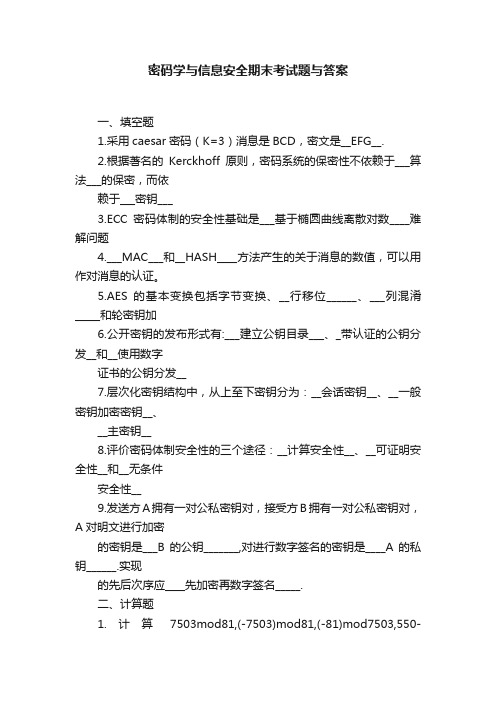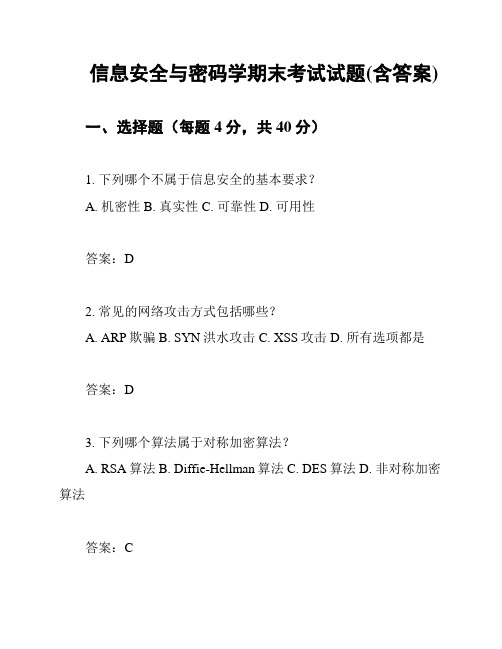final-13 密码学期末试题4
《密码学》期末考试试卷

多练出技巧 巧思出硕果一、 填空题(35分,1分/空)4.从熵的基本性质可推知,保密系统的 密钥量 越小,其密文中含有的关于明文的信息量就越大。
从密码系统设计者确度看,自然要选择足够大的 密钥量 ,而且希望从密文中提取的有关明文的信息尽可能地小。
5.为保证安全性,在设计分组密码时,密码变换必须足够复杂,尽量使用 混淆 与 扩散 原则。
这样使攻击者除了用 穷举 攻击以外,找不到其他简洁的数学破译方法。
6.DES 是一个 分组密码 算法,DES 是一个对称密码体制,加/解密使用同一密钥,同时DES 的加密与解密使用同一算法。
DES 的保密性依赖于 密钥 。
7.设),,,,(1111D E K C M =Φ和),,,,(2221D E K C M =Φ是两个密码体制,它们的明文和密文空间相同,1Φ和2Φ的乘积定义为密码体制(D E K K M C ,,,,21⨯),记为21Φ⨯Φ,这就是 所谓的 乘积 密码体制。
8.群是一个代数系统,它由一个非空集合G 组成,在集合G 中定义了一个二元运算“·”,满足:(1)封闭性,即:对任意的a,b ∈G ,有a ·b ∈G ;(2)单位元结合律,即:对任何a,b,c ∈G ,有a ·b ·c=(a ·b)·c=a ·(b ·c);(3)逆元,即:存在1G ∈一个元素,对任意元素a ∈G,(乘法运算满足)a ·1=1·a=a ;(4)即对任意a ∈G ,存在一个元素a1-∈G ,使得a ·a 1-= a 1-·a=1;把满足上面性质的代数系统称为群,记作<G,·>。
如果群<G,·>,还满足交换律,即对任何a,b ∈G 有a ·b=b ·a,则称G 为交换群。
9.唯密文攻击,是指密码分析者仅知道一些密文,并试图恢复尽可能多的明文,并进一步推导出加密信息的密钥。
密码学与信息安全期末考试题与答案

密码学与信息安全期末考试题与答案一、填空题1.采用caesar密码(K=3)消息是BCD,密文是__EFG__.2.根据著名的Kerckhoff原则,密码系统的保密性不依赖于___算法___的保密,而依赖于___密钥___3.ECC密码体制的安全性基础是___基于椭圆曲线离散对数____难解问题4.___MAC___和__HASH____方法产生的关于消息的数值,可以用作对消息的认证。
5.AES的基本变换包括字节变换、__行移位______、___列混淆_____和轮密钥加6.公开密钥的发布形式有:___建立公钥目录___、_带认证的公钥分发__和__使用数字证书的公钥分发__7.层次化密钥结构中,从上至下密钥分为:__会话密钥__、__一般密钥加密密钥__、__主密钥__8.评价密码体制安全性的三个途径:__计算安全性__、__可证明安全性__和__无条件安全性__9.发送方A拥有一对公私密钥对,接受方B拥有一对公私密钥对,A对明文进行加密的密钥是___B的公钥_______,对进行数字签名的密钥是____A的私钥______.实现的先后次序应____先加密再数字签名_____.二、计算题1.计算7503mod81,(-7503)mod81,(-81)mod7503,550-1mod723。
7503mod81=51(-7503)mod81=30(-81)mod7503=7423-1() ()()所以550mod1723=3542.在有限域GF(28)上计算多项式乘法:57*9D。
57*9D=(0101 0111)(1001 1101)=(0000 0001)(1001 1101)⊕(0000 0010)(1001 1101)⊕(0000 0100)(1001 1101)⊕(0001 0000)(1001 1101)⊕(0100 0000)(1001 1101)(0000 0001)(1001 1101)=(1001 1101)(0000 0010)(1001 1101)=(0001 1011)⊕(0011 1010)=(0010 0001)(0000 0100)(1001 1101)=(0000 0010)(0010 0001)=(0100 0010)(0001 0000)(1001 1101)=(0000 1000)[(0000 0010)(1001 1101)]=(0000 1000)(0010 0001)=(0000 0100)(0100 0010)=(0000 0010)(1000 0100)=(0001 1011)⊕(0000 1000)=(0001 0011)(0100 0000)(1001 1101)=(0010 0000)[(0000 0010)(1001 1101)]=(0010 0000)(0010 0001)=(0001 0000)(0100 0010)=(0000 1000)(1000 0100)=(0000 0100)[(0001 1011)(0000 1000)]=(0000 0100)(0001 0011)=(0000 0010)(0010 0110)=(0100 1100)所以:(0101 0111)(1001 1101)= (1001 1101)⊕(0010 0001)⊕(0100 0010)⊕(0001 0011)⊕(0100 1100)=(1010 0001)=A1三、简答题1.简述密码算法中对称、非对称算法各自的优缺点,及分析如何将两者进行结合应用。
密码学算法考试题及答案

密码学算法考试题及答案一、选择题(每题2分,共20分)1. 以下哪个不是对称加密算法?A. AESB. RSAC. DESD. 3DES2. 公钥密码体制中,公开的密钥被称为:A. 公钥B. 私钥C. 会话密钥D. 对称密钥3. 以下哪个是流密码的一个特点?A. 加密速度快B. 密钥长度固定C. 需要密钥交换D. 只适用于小数据量加密4. 哈希函数的主要特点不包括:A. 固定长度输出B. 抗碰撞性C. 可逆性D. 快速计算5. 数字签名的主要目的是什么?A. 保证信息的机密性B. 保证信息的完整性C. 验证信息的来源D. 加密信息6. 在密码学中,以下哪个概念与“完美保密”相关?A. 一次性密码本B. 对称加密C. 公钥加密D. 哈希函数7. 在密码学中,以下哪个算法用于生成伪随机数?A. AESB. RSAC. RC4D. SHA-2568. 以下哪个是密码学中常见的攻击类型?A. 重放攻击B. 拒绝服务攻击C. 缓冲区溢出攻击D. SQL注入攻击9. 在密码学中,以下哪个概念与“密钥管理”相关?A. 密钥生成B. 密钥分发C. 密钥存储D. 所有选项都是10. 以下哪个是密码学中“数字证书”的作用?A. 验证公钥的真实性B. 加密数据C. 存储私钥D. 作为数字签名答案:1. B2. A3. A4. C5. C6. A7. C8. A9. D10. A二、简答题(每题10分,共30分)11. 简述对称加密和非对称加密的区别。
12. 解释什么是数字签名,并说明其在电子商务中的应用。
13. 描述哈希函数在密码学中的作用及其主要性质。
答案:11. 对称加密使用相同的密钥进行加密和解密,速度快,适用于大量数据的加密。
非对称加密使用一对密钥,即公钥和私钥,公钥用于加密,私钥用于解密,适用于密钥分发和数字签名。
12. 数字签名是一种用于验证信息来源和完整性的密码学机制。
在电子商务中,数字签名用于确保交易的安全性,防止篡改,提供不可否认性。
南京邮电大学《密码学》2022-2023学年第一学期期末试卷

南京邮电大学《密码学》2022-2023学年第一学期期末试卷《密码学》考试内容:《密码学》;考试时间:120分钟;满分:100分;姓名:——;班级:——;学号:——一、选择题(每题2分,共20分)1. 密码学中最基本的加密方法是:A. 替换密码B. 移位密码C. 公钥密码D. 对称密钥加密2. RSA算法属于哪种类型的加密算法?A. 对称密钥加密B. 非对称密钥加密C. 哈希算法D. 流密码3. 如果发送方用私钥加密消息,则可以实现:A. 保密性B. 保密与鉴别C. 保密而非鉴别D. 鉴别4. 在混合加密方式下,真正用来加解密通信过程中所传输数据(明文)的密钥是:A. 非对称算法的公钥B. 对称算法的密钥C. 非对称算法的私钥D. CA中心的公钥5. 两个不同的消息摘要具有相同的值时,称为:A. 攻击B. 冲突C. 散列D. 都不是6. 以下关于数字签名的描述,不正确的是:A. 数字签名是一种用于验证消息来源和完整性的技术B. 数字签名在电子商务中确保了交易的安全性和不可抵赖性C. 数字签名是可复制的D. 数字签名是不可伪造的7. HASH函数可应用于:A. 用户的公钥B. 用户的私钥C. 自己的公钥D. 都不是8. 在RSA算法中,若取p=3, q=11, e=3,则d等于:A. 33B. 20C. 14D. 79. 以下哪种加密算法属于单钥制加密算法?A. DES加密算法B. RSA加密算法C. Diffie-Hellman加密算法D. AES加密算法(注:AES通常为对称加密,但此处为选项设置)10. 密码学中的“雪崩效应”是指:A. 混淆B. 扩散C. 当输入发生轻微变化时,输出将发生非常显著的变化D. 数字水印二、填空题(每题2分,共20分)1. 密码学是研究信息的______、______、完整性和不可否认性的科学和艺术。
2. 对称密钥加密,也称为私钥加密,意味着加密和解密使用______的密钥。
信息安全与密码学期末考试试题(含答案)

信息安全与密码学期末考试试题(含答案)一、选择题(每题4分,共40分)1. 下列哪个不属于信息安全的基本要求?A. 机密性B. 真实性C. 可靠性D. 可用性答案:D2. 常见的网络攻击方式包括哪些?A. ARP欺骗B. SYN洪水攻击C. XSS攻击D. 所有选项都是答案:D3. 下列哪个算法属于对称加密算法?A. RSA算法B. Diffie-Hellman算法C. DES算法D. 非对称加密算法答案:C4. 下列哪个算法不存在后门?A. RSA算法B. 椭圆曲线算法C. 双线性对算法D. 所有选项都不存在后门答案:D5. 下列哪个加密算法支持数字签名并且必须使用哈希函数?A. RSA算法B. ECC算法C. DSA算法D. 所有选项都是答案:C6. 消息认证码的作用是什么?A. 防止重放攻击B. 提供机密性C. 防止中间人攻击D. 提供数据完整性和真实性答案:D7. 下列哪个不属于数字证书中包含的信息?A. 颁发者名称B. 序列号C. 有效期D. 证书密码答案:D8. 下列哪个密钥交换算法是安全的?A. RSA算法B. Diffie-Hellman算法C. 椭圆曲线算法D. 所有选项都不安全答案:C9. 下列哪个密码协议用于在不安全的信道上安全地交换密钥?A. SSL协议B. S/MIME协议C. Kerberos协议D. 所有选项都可以答案:C10. 下列哪个安全协议使用了数据包的数字签名和IPsec的VPN技术?A. SSH协议B. SSL协议C. S/MIME协议D. IPSec协议答案:D二、判断题(每题4分,共20分)1. HMAC是用于提供机密性和真实性的消息认证码,答案是:错误答案:错误2. 非对称加密算法一般用于验证身份和身份证明,答案是:正确答案:正确3. 数字签名的目的是确保消息不被篡改和抵赖,答案是:正确答案:正确4. SSL协议是基于TCP协议的,答案是:正确答案:正确5. 随机数生成是RSA算法中非常重要的部分,答案是:错误答案:错误三、简答题(每题10分,共40分)1. 请简要介绍DES算法的加密模式。
密码学复习题

密码学复习题本页仅作为文档页封面,使用时可以删除This document is for reference only-rar21year.March密码学练习题一、单选题1、密码学包括哪两个相互对立的分支(B)A、对称加密与非对称加密B、密码编码学与密码分析学C、序列算法与分组算法D、DES和RSA2、加密技术不能提供以下哪种安全服务(D)A、鉴别`B、机密性C、完整性D、可用性3、在密码学中,需要被变换的原消息被称为什么(D)A、密文B、算法C、密码D、明文4、在凯撒密码中,每个字母被其后第几位的字母替换(C)A、5B、4C、3D、25、公元前500年的古希腊人曾使用了一种著名的加密方法,叫什么名字(A)A、Scytale密码B、凯撒密码C、代替密码D、置换密码6、在密码学中,对RSA的描述是正确的是(B)A、RSA是秘密密钥算法和对称密钥算法B、RSA是非对称密钥算法和公钥算法C、RSA是秘密密钥算法和非对称密钥算法D、RSA是公钥算法和对称密钥算法7、IDEA的密钥长度是多少bit(D)A、56B、64C、96D、1288、DES的密钥长度是多少bit(B)A、64B、56C、512D、89、RSA使用不方便的最大问题是(A)A、产生密钥需要强大的计算能力B、算法中需要大数C、算法中需要素数D、被攻击过很多次10、ECB指的是(D)A、密文链接模式B、密文反馈模式C、输出反馈模式D、电码本模式11、下列为非对称加密算法的例子为(D)A、IDEAB、DESC、3DESD、ELLIPTOC CURVE12、国际标准化组织在ISO 7498-2标准中定义了几类可选的安全服务(D)A、8B、7C、11D、613、下面关于密码算法的阐述,哪个是不正确的(C)A、对于一个安全的密码算法,即使是达不到理论上的不破的,也应当为实际上是不可破的。
即是说,从截获的密文或某些已知明文密文对,要决定密钥或任意明文在计算机上是不可行的。
密码学期末考试题及答案
密码学期末考试题及答案一、选择题(每题2分,共20分)1. 密码学中的“凯撒密码”属于以下哪种类型的密码?A. 替换密码B. 置换密码C. 公钥密码D. 序列密码答案:A2. 在现代密码学中,以下哪种算法属于非对称加密算法?A. DESB. AESC. RSAD. RC4答案:C3. 以下哪个选项不是哈希函数的特性?A. 确定性B. 快速计算C. 可逆性D. 抗碰撞性答案:C4. 对称加密算法中,加密和解密使用相同密钥的算法是:A. RSAB. AESC. Diffie-HellmanD. ECC5. 在密码学中,以下哪种攻击方式是通过猜测密钥来解密密文的?A. 重放攻击B. 侧信道攻击C. 差分攻击D. 穷举攻击答案:D6. 以下哪个选项不是数字签名的目的?A. 验证消息的完整性B. 验证消息的来源C. 确保消息的机密性D. 验证签名者的身份答案:C7. 在密码学中,以下哪种加密模式不提供消息认证?A. ECB模式B. CBC模式C. CFB模式D. OFB模式答案:A8. 以下哪个选项不是密码学中的攻击类型?A. 已知明文攻击B. 选择明文攻击C. 选择密文攻击D. 随机攻击答案:D9. 在密码学中,以下哪种技术用于防止重放攻击?B. 哈希函数C. 公钥加密D. 对称加密答案:A10. 在密码学中,以下哪个选项不是数字签名的组成部分?A. 哈希值B. 公钥C. 私钥D. 签名答案:B二、填空题(每题2分,共20分)1. 密码学中的“一次性密码本”被认为是理论上的________。
答案:完美安全2. 在密码学中,________算法可以保证即使在密钥泄露的情况下,之前的通信内容仍然安全。
答案:前向保密3. 密码学中的“________”是指在不知道密钥的情况下,无法从密文推断出明文。
答案:机密性4. 密码学中的“________”是指在不知道密钥的情况下,无法确定密文是否有效。
答案:认证性5. 在密码学中,________是指通过修改密文,使得解密后得到错误的明文。
密码学算法考试题及答案
密码学算法考试题及答案一、单项选择题(每题2分,共20分)1. 密码学中,以下哪个算法不是对称加密算法?A. AESB. RSAC. DESD. 3DES答案:B2. 在密码学中,以下哪个选项是正确的?A. 对称加密算法的密钥长度越长,安全性越高B. 非对称加密算法的密钥长度越短,安全性越高C. 对称加密算法的密钥长度越短,安全性越高D. 非对称加密算法的密钥长度越长,安全性越低答案:A3. 以下哪个算法是流密码?B. RSAC. RC4D. ECC答案:C4. 以下哪个是密码学中的哈希函数?A. AESB. RSAC. SHA-256D. ECC答案:C5. 在密码学中,以下哪个算法是数字签名算法?A. AESB. RSAC. DESD. SHA-2566. 以下哪个选项是密码学中的安全通信协议?A. HTTPSB. FTPC. HTTPD. Telnet答案:A7. 在密码学中,以下哪个算法用于生成伪随机数?A. AESB. RSAC. PRNGD. ECC答案:C8. 以下哪个选项是密码学中的公钥基础设施(PKI)?A. SSLB. CAC. PGPD. SSH答案:B9. 在密码学中,以下哪个算法用于数据完整性验证?A. AESB. RSAC. HMACD. ECC答案:C10. 以下哪个选项是密码学中的密码分析方法?A. Frequency analysisB. Brute forceC. Differential cryptanalysisD. All of the above答案:D二、多项选择题(每题3分,共15分)11. 以下哪些是对称加密算法的特点?A. 加密和解密使用相同的密钥B. 加密和解密使用不同的密钥C. 加密速度快D. 密钥分发和管理相对简单答案:A, C12. 以下哪些是数字签名的特点?A. 验证消息的完整性B. 验证消息的来源C. 提供消息的机密性D. 非对称加密算法用于签名答案:A, B, D13. 以下哪些是哈希函数的特点?A. 单向性B. 确定性C. 快速性D. 可逆性答案:A, B, C14. 以下哪些是公钥基础设施(PKI)的组成部分?A. 证书颁发机构(CA)B. 证书撤销列表(CRL)C. 数字证书D. 非对称加密算法答案:A, B, C15. 以下哪些是密码学中的攻击类型?A. 频率分析B. 侧信道攻击C. 差分密码分析D. 已知明文攻击答案:A, B, C, D三、填空题(每题2分,共20分)16. 对称加密算法中,最著名的算法之一是_________。
密码学选修课期末试卷及答案
1.凯撒大帝在密码学上很有造诣,试运用密码对一段信息I like the course:stay of cryptography加密,密钥为3~6中的一个2.有人说密码无门槛,也有人说密码高不可攀,试说说你眼中的密码学解:无门槛:举例:(1)研究密码的人员。
在《四十号房间》这个故事中尤因爵士组织的一个破密班子全部由业余爱好者组成,包括神职人员、股票经纪人、银行家、海军学校教师到大学教授的各色人等。
(2)密码应用的方面。
密码的应用可以说是无处不在,尤其是日常生活中,例如银行卡,网银,网店,QQ,手机锁自动柜员机的芯片卡、电脑使用者存取密码、电子商务等等。
高不可攀:(1)从安全方面讲:不安全的密码比没有密码更不安全(2)密码要求高:密码学要求基础要深,技术要强,必须是专业人员经过专业培训,专业训练才能胜任这份工作。
例如数学家有扎实的数学基础,计算机学家有相关的专业知识,物理学家有量子物理学的基础,生物学家掌握DNA方面的知识,密码学家也有相当丰富的专业知识。
3.有这样一个观点:要成为密码学家首先要成为数学家、计算机学家、生物学家等等成为其他方面的专家,谈谈自己对此的体会,试举例说明解:密码学是在编码与破译的斗争实践中逐步发展起来的,并随着先进科学技术的应用,已成为一门综合性的尖端技术科学。
它与语言学、数学、电子学、声学、信息论、计算机科学等有着广泛而密切的联系。
成为密码学家必须要有相关的密码学知识和相应的研究手段,不同专业领域的人员组成一个团体,各尽所能,致力于密码学研究。
例如:(1)语言学家:对英语、法语、德语或者其他小语种有研究的人,遇到熟悉的语言可以发挥优势,在电影《风语者》中美军使用了一种极少数人懂的印第安某部落的语言,在战争发挥了极大作用,直到战争结束仍未被破解。
(2)数学家:数学家有代数、数论、概率等专业知识,对破解密码有相当大的优势。
《跳舞的小人》中福尔摩斯就是通过字母“E”在英语中出现的频率最高,以此为突破口来破解密码(3)物理学家:物理学家有量子理论和通讯理论的专业知识,例如在《信息论与编码》这门课程中我们学习了,1949年美国人香农发表了《秘密体制的通信理论》一文,应用信息论的原理分析了密码学中的一些基本问题。
密码学期末试题
密码学期末试题本页仅作为文档页封面,使用时可以删除This document is for reference only-rar21year.March密码学期末试题一.选择题1、关于密码学的讨论中,下列( D )观点是不正确的。
A 、密码学是研究与信息安全相关的方面如机密性、完整性、实体鉴别、抗否认等的综 合技术B 、密码学的两大分支是密码编码学和密码分析学C 、密码并不是提供安全的单一的手段,而是一组技术D 、密码学中存在一次一密的密码体制,它是绝对安全的2、在以下古典密码体制中,属于置换密码的是(B )。
A 、移位密码B 、倒序密码C 、仿射密码D 、PlayFair 密码 3、一个完整的密码体制,不包括以下( C)要素。
A 、明文空间 B 、密文空间 C 、数字签名 D 、密钥空间4、关于 DES 算法,除了(C )以外,下列描述 DES 算法子密钥产生过程是正确的。
A 、首先将 DES 算法所接受的输入密钥 K (64 位),去除奇偶校验位,得到 56 位密钥(即经过 PC-1 置换, 得到 56 位密钥)B 、在计算第 i 轮迭代所需的子密钥时,首先进行循环左移,循环左移的位数取决于 i 的值,这些经过循环 移位的值作为下一次循环左移的输入C 、在计算第 i 轮迭代所需的子密钥时,首先进行循环左移,每轮循环左移的位数都相同,这些经过循环移 位的值作为下一次循环左移的输入D 、然后将每轮循环移位后的值经 PC-2 置换,所得到的置换结果即为第 i 轮所需的子密钥 Ki5、2000 年 10 月 2 日,NIST 正式宣布将( B )候选算法作为高级数据加密标准,该算法是由两位比利时密 码学者提出的。
A 、MARSB 、RijndaelC 、TwofishD 、Bluefish*6、根据所依据的数学难题,除了( A )以外,公钥密码体制可以分为以下几类。
A 、模幂运算问题C 、离散对数问题 B 、大整数因子分解问题D 、椭圆曲线离散对数问题7、密码学中的杂凑函数(Hash 函数)按照是否使用密钥分为两大类:带密钥的杂凑函数和不带密钥的杂凑函数,下面( C )是带密钥的杂凑函数。
- 1、下载文档前请自行甄别文档内容的完整性,平台不提供额外的编辑、内容补充、找答案等附加服务。
- 2、"仅部分预览"的文档,不可在线预览部分如存在完整性等问题,可反馈申请退款(可完整预览的文档不适用该条件!)。
- 3、如文档侵犯您的权益,请联系客服反馈,我们会尽快为您处理(人工客服工作时间:9:00-18:30)。
CS255:Cryptography and Computer Security Winter2013Final ExamInstructions:−Answer allfive questions.−The exam is open book and open notes.Wireless devices are not allowed.−Students are bound by the Stanford honor code.−You have two hours and thirty minutes.Problem1.Questions from all over.a.Let p be a large prime and g∈Z∗p of order p−1.Is the function f(x)=g x in Z p whosedomain is{1,...,p−1}a trapdoor one-way function?Justify your answer.b.Briefly explain the main idea for building an authenticated key exchange protocol(secureagainst man in the middle attacks)from the basic Diffie-Hellman protocol.c.Let(N,e)be an RSA public key.Recall that to sign messages using RSA-FDH we usea hash function H:{0,1}n→Z N and compute the signature on a message m asσ←H(m)d in Z N.Suppose the adversary canfind two messages m1,m2such thatH(m1)=H(m2)·2e in Z N.Does this let the adversary break RSA-FDH?That is,canthe adversary create an existential forgery using a chosen message attack?d.Same question as part(c)except that the adversary canfind two messages m1,m2suchthat H(m1)=H(m2)+1in Z N.Briefly justify your answer.e.When storing hashed and salted passwords in a passwordfile,what is the purpose of usinga slow hash function?Problem2.Variants of CBC encryption.a.One problem with CBC encryption is that messages need to be padded to a multiple ofthe block length and sometimes a dummy block needs to be added.The followingfiguredescribes a variant of CBC that eliminates the need to pad:The method pads the last block with zeros if needed(a dummy block is never added),but the output ciphertext contains only the shaded parts of C1,C2,C3,C4.Note that,ignoring the IV,the ciphertext is the same length as the plaintext.This technique iscalled ciphertext stealing.(1)Explain how decryption works.(2)Can this method beused if the plaintext contains only one block?1b.Another problem with CBC encryption is that it cannot be sped up by parallel processing.The followingfigure shows a variant of CBC that supports2-way parallelism.It can besped up by a factor of two using two processors.Here E is the encryption algorithm of a secure PRP such as AES.Suppose one choosesIV0at random and sets IV1=IV0⊕B for somefixed public constant B(e.g.B=1nwhere n is the block size of E).Is the resulting system CPA-secure?If yes,briefly explainwhy(it’sfine to rely on theorems presented in class).If not,describe an attacker thatwins the CPA security game.c.Suppose one chooses IV0at random and sets IV1=k where k is part of the secretkey.That is,the secret key is(k,k )and this secret key is used to encrypt multipleplaintexts.Is the resulting system CPA-secure?If yes,briefly explain why(it’sfine torely on theorems presented in class).If not,describe an attacker that wins the CPAsecurity game.d.Suppose one chooses IV0and IV1independently at random and includes both in theciphertext.Is the resulting system CPA-secure?If yes,briefly explain why(it’sfine torely on theorems presented in class).If not,describe an attacker that wins the CPAsecurity game.Problem3.Let(E,D)be an encryption system that provides authenticated encryption.Here E does not take a nonce as input and therefore must be a randomized encryption algorithm.Which of the following systems provide authenticated encryption?For those that do briefly explain why.For those that do not,present an attack that either breaks CPA security or ciphertext integrity.a.E1(k,m)=c←E(k,m),output(c,c)and D1(k,(c1,c2))=D(k,c1)b.E2(k,m)=c←E(k,m),output(c,c)and D2(k,(c1,c2))=D(k,c1)if c1=c2fail otherwisec.E3(k,m)=E(k,m),E(k,m)and D3(k,(c1,c2))=D(k,c1)if D(k,c1)=D(k,c2)fail otherwiseTo clarify:E(k,m)is randomized so that running it twice on the same input will result in different outputs with high probability.d.E4(k,m)=E(k,m),H(m)and D4(k,(c1,c2))=D(k,c1)if H(D(k,c1))=c2fail otherwisewhere H is a collision resistant hash function.2Problem4.Two-time secure encryption.Recall that the one-time-pad is a one-time encryption system that is secure against infinitely powerful adversaries.Our goal in this question is to design a2-time secure encryption against infinitely powerful adversaries.If the encryptor can be stateful then the problem is trivial—simply use two one-time pads.Here,we de-sign a stateless2-time secure system:every encryption is done independently of the other encryptions.a.Give a precise definition for what it means for a symmetric encryption system to besemantically secure when a secret key is used to encrypt at most two messages.Makesure to define two experiments EXP(0)and EXP(1)as in the definitions of semanticsecurity and CPA security.Keep in mind that the adversary can be adaptive:its choicefor a second message to encrypt may depend on thefirst ciphertext it receives.b.Show that the one time pad is insecure under your definition from part(a).Can anydeterministic encryption system(without a nonce)be secure under your definition?c.Let p be a128-bit prime and consider the following encryption system:the secret key is arandom pair(x,y)∈(Z p)2and to encrypt a message m∈Z p do:choose a random r R←Z p and output the ciphertext(r,xr+y+m)∈Z2p.Explain how to decrypt a given ciphertext(c1,c2)using the secret key(x,y).d.Show that this system is2-time secure(using your definition from part a.)against infinitelypowerful adversaries.d.1.Let S be the set of all4-tuples(x,y,r0,r1)in Z4p such that r0=r1.First arguethat if the tuple(x,y,r0,r1)is uniform in S then the tuple(xr0+y,xr1+y,r0,r1)is also uniform in S.To do so,show that the following mapping from S to S isone-to-one:(x,y,r0,r1)→(xr0+y,xr1+y,r0,r1)All you need to do is show that this mapping is invertible.e(d.1)to argue2-time security.In particular,show that the adversary’s advan-tage is at most1/p in distinguishing EXP(0)from EXP(1).Hint:There are two cases:•First argue that if the the nonces r0,r1in the two ciphertexts given to the adver-sary are distinct then the adversary has advantage0in distinguishing EXP(0)from EXP(1).To show this observe that the property from(d.1)implies thatwhen encrypting two messages m0and m1in Z p with distinct nonces r0=r1theresulting ciphertexts(r0,xr0+y+m0)and(r1,xr1+y+m1)are distributed as(r0,s0)and(r1,s1)where s0,s0are uniform random variables in Z p independentof m0and m1(i.e.(s0,s1)are distributed the same for all(m0,m1)).•if the nonces r0,r1in the two ciphertexts given to the adversary are the samethen the adversary can distinguish EXP(0)from EXP(1).However,observe thatr0=r1happens only with probability1/p.e.Show that the system from part(c)is not3-time secure.That is,show that the adversarydistinguish EXP(0)from EXP(1)after making three chosen plaintext queries.3Problem5.Encryption-based challenge-response identification.In class we discussed MAC-based and signature-based challenge-response identification.Recall that the purpose of challenge-response identification is to defeat attackers capable of mounting an active attack on the identification system.In this question we consider a variant of challenge-response identifica-tion based on an encryption scheme rather than a MAC.Let(E,D)be a symmetric encryption system defined over(K,M,C).The identification system works as follows:•setup:generate a random key k∈K and set sk←k and vk←k.The same key k willbe used for all runs of the identification protocol.•identification:the verifier generates a random message m∈M and sends c←E(k,m)to the prover.The prover responds with m ←D(k,c).The verifier accepts if m=mand rejects otherwise.a.For each of the following encryption schemes determine if this identification method issecure.If it is secure explain why.If not,present an attack.a.1.(E,D)is the one-time pad with K=M=C={0,1}128.a.2.(E,D)is AES-based CBC encryption with a random IV where the message spaceM is{0,1}128.a.3.(E,D)is AES-based GCM encryption where the message space M is{0,1}128.b.Suppose the key k is derived from the user’s password(i.e.k is computed via a publicdeterministic function applied to the password).Can an eavesdropper who obtains thetranscript of a successful identification carry out a dictionary attack to expose k?If soexplain why.If not,explain why not.c.As is,the protocol assumes that vk is kept secret on the server.Can you propose amodification to the protocol so that making vk public would not affect security?4。
